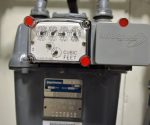That thing launched at Gatwick still hasn’t landed, and might not be able to
If the Gatwick drone incident teaches one thing, it’s this: remote controlled vehicle enthusiasts need an alibi when the planets rise in the airspace above Britain’s airports. In that way, they may avoid winding up in jail when police exploit busy-bodying tip-offs, from the sort of stupid people who are always mistaking lights on cranes for unidentified flying objects, in order to make an example of innocent members of the public for the purpose of creating an impression that a crime has been committed (in support of a drone-in-restricted-airspace psyop).
While, the above paragraph should not be adopted automatically as a perspective, it does represent the sort of thing one would expect to find, these days, at the bottom of a news event that exists solely to drive an agenda: in short, the Gatwick drone incident of the week before Christmas reeks of being a work of wizardry rendered by the usual suspects: please note the thinly concealed smoudering rage and perturbation at the heart of Government regarding some accidental undermining by Sussex Police (the nature of which we will get to momentarily):
In an hour-long conference call with Transport Secretary Chris Grayling, it was acknowledged police ‘have not handled their communication response well’.
Government sources told The Sun that a combination of wrong police protocols and poor media management caused yesterday’s slip-up.
There was also the clue in the corporate-media’s “trial by circus arena” treatment of the arrest of Crawley couple, Paul Gait and Elaine Kirk, in relation to the incident. As usual in cases like these, nameless neighbours were mouthpieces for information by which the public was supposed to nudge and wink and assume guilt. Headlines in the Mail on Sunday termed the pair “morons” – thus perhaps negating the question mark at the end of the sentence asking if they had ruined Christmas (for delayed air passengers).
 In fact, so offensive on this occasion was the incrimination (probably because the victims of it hadn’t previously been accused of being terrorists) that it drew criticism from other parts of corporate-media: such things are necessary for retaining what little bits of credibility remain. As a matter of fact, the arrests in themselves produced an unmistakable odour of fish, and as such the events in total had more than a whiff of government-by-deception about them.
In fact, so offensive on this occasion was the incrimination (probably because the victims of it hadn’t previously been accused of being terrorists) that it drew criticism from other parts of corporate-media: such things are necessary for retaining what little bits of credibility remain. As a matter of fact, the arrests in themselves produced an unmistakable odour of fish, and as such the events in total had more than a whiff of government-by-deception about them.
When Detective Chief Superintendent Jason Tingley, of Sussex Police, spoke to the BBC on 23rd December, he had a number of interesting things to say. The most significant of these was a confession, neatly covered in the following extract taken from the Evening Standard:
An officer investigating the drone chaos at Gatwick Airport says there is no footage of the device which sparked it and it is “a possibility” there never was one.
Asked about speculation there was never such a drone flown over the airport, Detective Chief Superintendent Jason Tingley told the BBC: “Of course, that’s a possibility. We are working with human beings saying they have seen something.
“Until we’ve got more clarity around what they’ve said, the detail – the time, place, direction of travel, all those types of things – and that’s a big task.”
What this tells us is that at the beginning of this incident Sussex Police were responding to nothing more material than eyewitness accounts of drone sightings. Although corporate-media has latterly produced unverified footage of a dark object in a portion of sky, accompanied with necessary question “is this the drone?”, at the time Tingley spoke to the BBC, solid evidence of a drone invading Gatwick airspace did not appear to exist.
Of course, this is all very interesting when one discovers that the first sightings of a “drone” took place at 9pm, Wednesday 19th December†, and so therefore at a time when sunset would have been 6 hours old. This begs a simple question: did people see a drone, or did they see a light in the sky? Did people actually discern an object to a degree that they could identify it as a UAV [unmanned aerial vehicle], or did they see something harmless or natural that has been presented as being a drone for the purposes of mischief?
Moreover, Sussex Police has been known to fly its own drones in the vicinity of Gatwick as part of the surveillance system of the airport: at least, the concept was trialled in 2014, as an ITV article from the time retails. Indeed, in a very recent development, the Chief Constable of Sussex Police, Giles York, told‡ the BBC yesterday that:
Of course, we will have launched our own Sussex Police drones at the time with a view to investigate, with a view to engage, with a view to survey the area looking for the drone, so there could be some level of confusion there.
This has widely been interpreted as an admission that police drones operating during the 36-hour period in which Gatwick was shutdown have been reported as rogue aircraft by tattle-happy members of the public. However, and perhaps we shouldn’t be surprised, Giles York did not venture into territory regarding routine drone fights by police at Gatwick in order to confirm or deny that such operations continued beyond the 2014 trials. There was, then, no effort to clarify if a police drone had set off the initial alarm, although Giles York was adamant about the reality of a drone improperly entering restricted airspace, saying that he was “absolutely certain that there was a[n illicit] drone flying throughout the period that the airport was closed”. That the Chief Constable would insist on this idea is no surprise, given that his appearance on the BBC would have been expressly necessary for dealing with the narrative-busting emerging question of police drone usage. Such a thing can be said because of the clear usage of the technique by which “conspiracy theory” is disarmed; the co-opting of the evidence to the contrary: i.e. cease omitting the data which is inconvenient for the lie, but present it selectively to continue hiding the truth.
As the FBEL reader will know all too well, incompetence is always the cover story. It is not beyond the realms of possibility that Sussex Police launched drones in the period Gatwick was shutdown in order to deliberately heighten public alarm, and therefore to provide further justification for prolonging the situation where planes could not operate at the airfield as usual. And far from helping Sussex Police off the hook, Chief Constable York in fact reminded of the shaky ground that it inhabits. The first sighting of his “absolute… certain[ty]” must have been in the dark where, as Tingley appeared to be pointing out, witnesses of it (if there were any) might have been mistaken about what they saw.
So, this is all very interesting for the context of the arrest of Gait and Kirk, a former soldier and his wife – despite the different surnames, on 21st December (with both being released without charge sometime in the following 24-36 hours [the author cannot ascertain from the coverage exactly when this was]). And one can well understand that while there has been plenty of chatter in corporate-media about the prospect of some sections of the corporate-media being sued (a strawman), there is nothing about the possibility of suit against Sussex Police for wrongful arrest.
Like Jason Tingley before him, Giles York was also convinced that there was no reason to apologise for arresting Gait and Kirk, although York’s expression of regret for what it meant to the couple to be arrested has been spun as police saying sorry (a public relations exercise). In reality, for Sussex Police to apologise would be to make an admission of wrongdoing, so this isn’t going to happen. Instead, both Tingley and York have insisted that the arrests were lawful, by which they mean legal: the swapping out of the latter for the former is a trick to create the impression that the police have a right to incarcerate a person doing something contrary to Government designs; (if you do not consent to the legislation that police are trying to uphold by arresting you, then police action boils down to common assault and kidnapping – see here for a fuller discussion).
In any case, for police to make a “lawful arrest”, the suspect must be confronted with a piece of information: the crime for which the arrest is being made. When pressed on the matter by a Twitter user, Sussex Police explained that it was investigating the incident under the Aviation and Maritime Security Act. Of course, this does not specify a particular offense under the particular act, and if, by such a response, we are to suppose that Sussex Police does not know what specific crime was committed, then we should not be at all surprised. Even now, with today’s news that a couple of drones have been discounted as potential Gatwick airspace violators, the only evidence whereby police have established that a crime has been committed are UFO sightings [unidentified flying objects – not aliens (there is no such thing)]. We can say this because nothing has fundamentally changed since Jason Tingley confessed that eyewitnesses might not have understood what they had been seeing, and therefore there was a chance that no one had seen a drone over Gatwick at all. On hindsight, maybe we can say that he was also indicating an understanding that people would be reporting police drone flights back to police.
We must wonder, then, what the police told Gait and Kirk when they were arrested for being suspected of a crime that had yet to be established as having been committed.
The British Government can afford to have its corporate-media propaganda industry get sued, but it can’t afford Council Tax revenue [which gets stolen from some of us] to translate into payouts for claimants and their solicitors in court cases against police. So, if there was an element of dangerous risk-taking by Sussex Police in making what we might call a premature arrest in this case, it must have been very important to the operation of the exercise. Indeed, the arrest of Gait and Kirk was for the purpose of creating an impression in the public that, in the absence of any hard and fast evidence, and to overcome the consequent nebulosity of the incident felt by a public distant to it, a crime had in fact been committed. It’s no wonder that “neighbours and friends rallied around the couple and claimed that they had been used as ‘scapegoats’ by Sussex Police” (source).
In fact, the arrests were reminiscent of the one made in by Sussex Police in the so-called Valerie Graves so-called murder case at Bosham – which this site has also covered. A man was taken into custody (and later released without charge) after a hammer declared by police to be a murder weapon was discovered as if discarded in a field near the arrested man’s house. From that incident, Sussex Police launched an attempt to collect records for a consensual DNA-database – with the consent being obtained by deceit – from two villages near Chichester. There are some things being said by police this time around that serve to warn that a similar exercise is going to be attempted in environs around Gatwick. It was said, above, that Jason Tingley had had a number of interesting things to tell the BBC; the second of these occurs in the following extract (note the use of the term “alleged crime”):
Mr Tingley said police are running a three-pronged investigation into the alleged crime…
He explained the examination [of a damaged drone] could be hampered by the wet weather on Friday and Saturday, which could have washed away evidence…
“We are interviewing those who have reported these sightings, are carrying out extensive house to house enquiries and carrying out a forensic examination of a damaged drone found near the perimeter of the airport near Horley, which is close to the last reported sighting”.
As indicated before, the drone mentioned in the extract was on Saturday 29th December (yesterday) discounted as evidence, and thus the device to justify a biometric trawl through the local populace has not yet been found (or discarded in dismay at the weight of incredulity that actually exists in public – at least as it is represented on social media). Moreover, there are other possible explanations for what happened at Gatwick airport. In a piece of news that looked all too suspiciously close in proximity to the national embarrassment that the Gatwick incident was said by corporate-media to constitute, a French company, Vinci Airports, purchased a £2.9bn controlling stake in the operation. Some have suggested that the incident was something to do with making the cost of the purchase lower than what it should have been: a grand exercise in share price fixing, or something along those lines. Before making this accusation, however, one should make an examination of publically available records to see if they land any credence to the theory. We should also note that prior to the purchase, Gatwick made sudden and expensive improvements in relation to anti-drone security; maybe the least we can say is that the incident presented Gatwick’s owners to take “emergency measures” (£5 million’s worth) that might sweeten the deal without raising the price? It must also be recognised that such an incident might provide a boon for those who want to install military grade security apparatus into civilian sectors for the full panopticon surveillance society, and the BBC has reported that “detection systems are now able to be deployed throughout the UK to combat the threat of drones, ministers say.” In fact, what the Government can make out of a crisis is something to consider in all these scenarios, even if they appear on face value to concern private enterprise.
And then it shouldn’t be forgotten that in the populace living in the environs around Gatwick is a good deal of opposition to any expansion of the airport – something that the Government would very much be involved in. The reader may have noticed the causal manner in which corporate-media has been accusing “eco-warriors” of being potential culprits – although of course, it should be remembered, that the crime still remains alleged. It could well be the case that the incident was meant to create outrage in the wider country against “nimbys” who dare to object about having to live under airplane flight paths.
Whatever the motivation, at this juncture, what can be stated with some certainty is that police have not demonstrated that a crime has even taken place: there is no reason whatsoever to take Chief Constable York on his word. The thinking at FBEL is that there was never a drone in the first place, and that an impression that there had been one was created by Sussex Police’s own drone flights. Furthermore, creating the psychological certainty in the public of a crime having been committed was achieved by the too-early arrest of scapegoats. For those of us who are interested in cataloguing and examining state crime and police cover up, whether or not Gait and Kirk sue probably has ramifications for understanding what happened in the most complete way possible, and so we await to see what happens in those regards.
† “Gatwick was closed on Wednesday evening (December 19) after two drones were spotted flying over the airfield at 9.03pm.” (Source).
‡ Sky News appears to have changed its headline from “Police admit some Gatwick sightings may have been their drones” to “Gatwick drone inquiry: 93 ‘credible sightings'”.


















